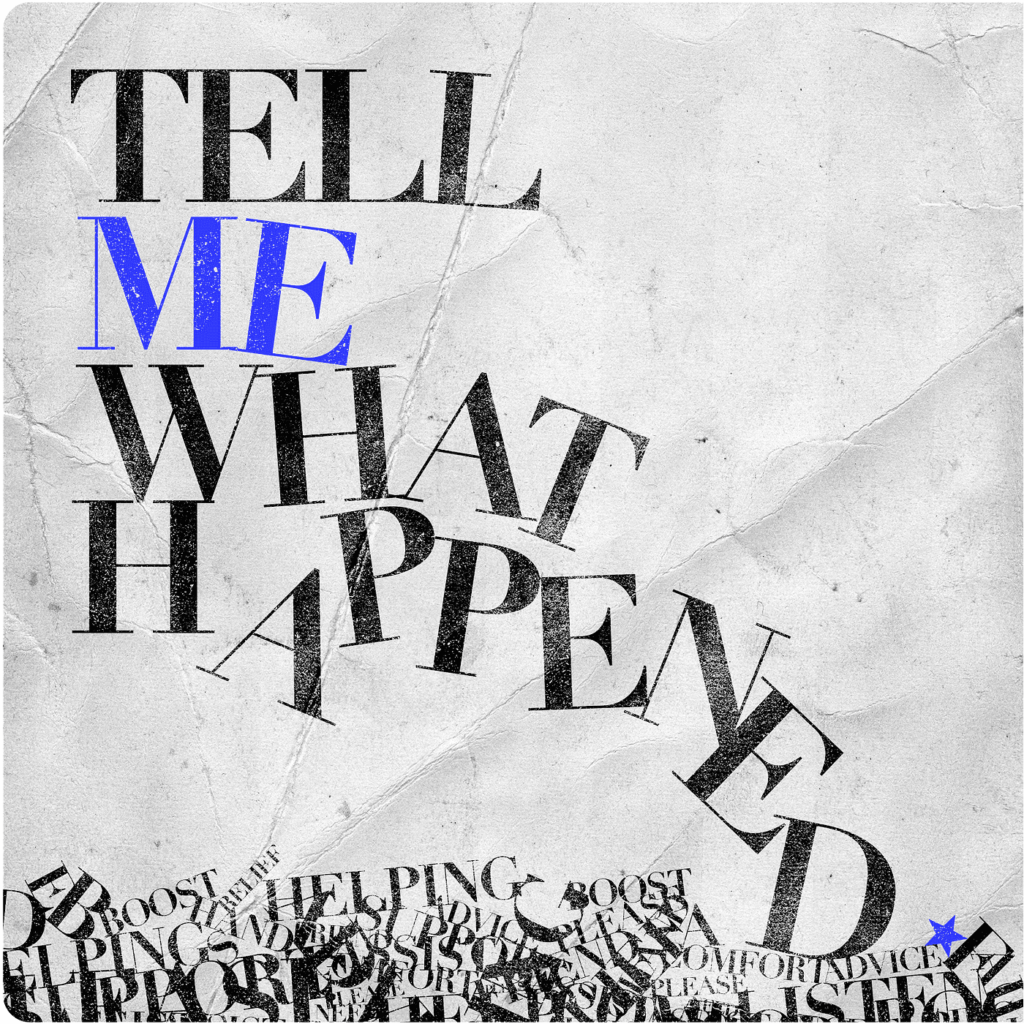First (Podcast) Impressions

The show Tell Me What Happened is a podcast about people helping people. It reflects the brand that created it — OnStar, whose advisors help people in times of crisis. I’m a fan of the show’s name, not only because it’s the question we ask someone who has a story to tell but because this phrase is also at the heart of the brand.
This is the story of how we landed on a name for Tell Me What Happened.
A catchy name can grab the attention of a prospective listener and should hint at what the show might be about. So as podcast creators it’s crucial to spend some time creating the most appealing title.
Sure, the editorial team creating the show can weigh in with their suggestions, but the decision with a brand’s show ultimately comes down to the client. That client will have ideas for what it should be called. So, what do you do when they come up with a name that they love? Roll with it!
…But there are some steps you can take before it gets the green light.
Before your client reaches the naming stage, we walk them through a few checkpoints. The idea is that you are guiding them toward a name that they will love, and that also makes sense for their brand.
✓ Checkpoint 1: Naming best practices
Miriam Johnson works on our Audience Development team and points to these best practices when choosing a name for a new show:
Be clear and identify what the show is about.
“A bad show name is vague, like ‘Feels’ or ‘Good Things.’ A great name lets a listener know what they are going to get and how this show might be different from another show.”
Be captivating and intriguing.
“The average person [looking for a new podcast to listen to] is scrolling [through a podcast app]; wanting to see whatever sort of candy appeals to them. So that candy needs to be appealing right away.”
Be subtle — when it comes to branding. Remember the phrase ‘less is more.’
“We actively discourage brands from having much of a brand touch at all. Whether that’s too much of a brand touch in the stories they’re sharing or their brand name on their artwork.”
Miriam says the show Choiceology is a great example of a show name— “It’s clear that it’s about making choices, the colours pop, and the illustrations indicate that you’re trying to figure out which way to turn.”
✓ Checkpoint 2: Survey the landscape. Does your podcast name sound familiar?
If you want an example of how a show about a podcast topic can have numerous different names, open your podcast player and search for shows about ‘bees.’
You’ll find shows like Two Bees in a Podcast, The Beekeepers Corner, The Hive Jive, Barefoot Beekeeper, Beekeeper Confidential, The Honest Bee, Beekeeping Today.
I may be judging a book by its cover (that’s often how some of us pick a new show to listen to) but I think it’s safe to assume these shows are all about the same topic of bees and beekeeping. Great in the sense that it does what it says on the tin. However, the names all share similar phrasing. So how do you stand out in a crowd, with a catchy and meaningful name?
The answer is often right in front of us — brands have spent years developing slogans and refining positioning statements, logos and colours, fonts, imagery, and sonic identity. Why not harness what they have already developed and find a podcast name that is unique to the brand?
OnStar and its marketing agency Campbell Ewald are now in the second season of producing the award-winning original show Tell Me What Happened. When we pitched ideas for names to the team we chose ones that we believed captured what the show was aiming to achieve while aligning with the brand’s values: Stories of Humanity, Everyday Heroes, and The Face of Bravery just to name a few.
But what Campbell Ewald came back to us with was a name that did that and then some by incorporating a phrase that is used by OnStar employees daily. When someone hits the OnStar button during an emergency, an advisor hops on the line and says the phrase “tell me exactly what happened….”
We assisted with best practices for naming a show and steered our client in the right direction. Campbell Ewald knew the brand they represented the best and came up with a unique name that captures the show’s concept and purpose.
I asked Campbell Ewald how they landed on the name. Editorial Director, Dan Grantham says their team felt like the name was a piece of the brand and “still reflected the show content — people are literally talking about what happened to them.” They shortened the name to ‘Tell Me What Happened’ to fit in search boxes and apps better. But the meaning stayed the same, “It feels directly tied to the content but also ties in the brand in a very specific way, so we love that. And, it’s a little unique, intriguing enough maybe to get someone interested in listening.”
What do you do if that name already exists?
With over 2.8 million podcasts floating around you may still need to differentiate yourself — artwork is of course one way to draw attention. But looking at what those shows are and how they overlap can give you a better understanding of how your show’s name may survive. Does a show with the same name still release content? If it doesn’t then there’s no need to worry about it. Does it live in the health and wellness genre and yours in the automotive? Uncovering a show with the same name doesn’t mean you need to kibosh your idea, it just means you need to find alternative ways to stand out from the crowd and utilize your brand’s identity to its full potential.
If the client just happens to land on a name that already exists in the podcast space (like Tell Me What Happened), it’s not ideal but it can still work effectively. We did a background check on the name Tell Me What Happened. As it turns out it’s a song by the Australian punk-folk band The Rumjacks, it’s the title of at least two books, and it’s the name of another podcast. Miriam Johnson says that “whatever podcast is more popular, will end up coming up first in terms of search results.” With distinctive artwork and regular content, our show now appears first in search results and pops off the page. While the right name is crucial, it goes hand in hand with the artwork and content.
✓ Checkpoint 3: Visualize the name. Support your title with art.
Once you’ve guided your client to a name that meets all the requirements and everyone agrees, support it with a visual identity. Not with just any visuals, but with artwork that jumps out from the page and also suits the name of the show (think wine pairings).
The majority of the time that listeners are interacting with your show they’ll be exposed to your series-level or episodic artwork — harness that opportunity. With Tell Me What Happened, we decided to lean on the question that the show’s name asks. Using newspaper and magazine clippings to form the basis of the artwork, asking the question ‘Tell Me What Happened.’ It speaks to the story format of the show, but also the journalistic element in how we tell our guests’ stories.

Tell Me What Happened resonates with listeners — it’s clear what the show is about from the start (both in name and in its artwork) and lives up to that promise.
Miriam Johnson’s biggest takeaway on naming your show: “Do not be vague in a show name. Be super clear and concise and let listeners know exactly what they’re getting into… Your show name rarely appears on its own. It will almost always appear in tandem with podcast cover art.”
To summarize:
- Guide your client towards a name that makes sense for the show, they are making.
- Look inwards when discussing show names. The best ideas are often those from within the organization from the folks that can shine a light on areas of the business that might not be obvious to those creating the content.
- Make sure the name you choose is clear and identifies what the show is about while keeping it intriguing.
- Check to see if your name already exists. Will it need additional support to appear first in search results, or do you need to go back to the drawing board.
- Support your title with artwork. The name of the show will almost always appear with artwork — make sure they complement each other.
If you want to dig into the numbers and science behind show names make sure you take a look at this great blog post written by Dan Misener a few years ago.
Sign up for the Pacific Content Newsletter: audio strategy, analysis, and insight in your inbox.
